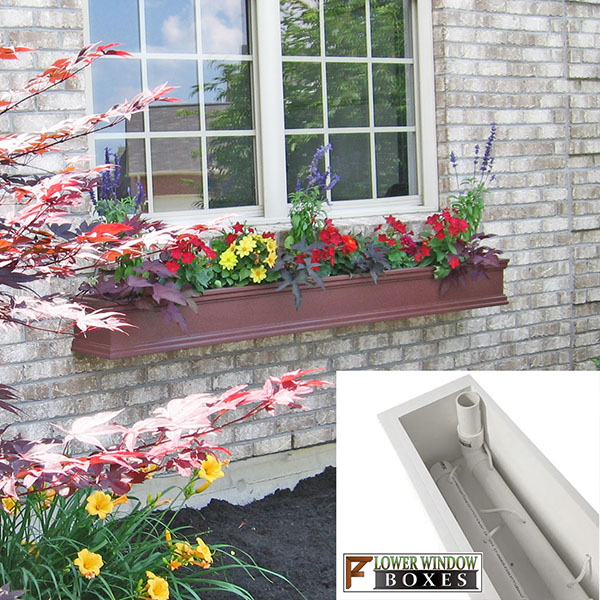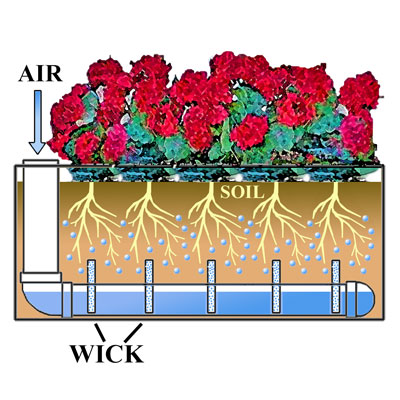
Self Watering Window Boxes and Planters
Self watering window boxes have become extremely popular in that they keep your window boxes and planters looking healthy even when you don't have the time to maintain them. With our self watering reservoir system, you may take longer trips away from home and not worry that your plants will fade or get sick. The technological solution that allows our flower box to become a self-watering flower box is our patented wicking water reservoirs. Each self-watering reservoir has the ability to store up to an additional gallon of water or more below the root surface and release it gradually in the soil allows you to water your plants 3-5 times less frequently.
"They're perfect for people with a busy lifestyle and for vacations!"
How Does Our Self Watering Window Boxes Work?

Our patented
window box water reservoir is a simple tube shaped self-watering system that
stores up to 1.5 gallons or more of extra water at the bottom of your window box to turn it into a
self-watering window box. As the soil dries out from various factors like sun and root uptake, it works by wicking water upward from the reservoir to the wicks and into the soil.
Normally, an excess of standing water in the planter would drown out roots and result in plant death. With our system, as the soil dries out, more water is drawn from the watering reservoir into the wick to act as an automatic
self watering system to keep your soil watered but not drown out your roots.
|
|
-
No rot - Lifetime Guarantee
Self Watering Option
Sales start at $99.99
-
-
No rot - Lifetime Guarantee
Self Watering Option
Sales start at $79.99
-
No rot - Lifetime Guarantee
Self Watering Option
Sales start at $144.99
-
No rot - Lifetime Guarantee
Self Watering Option
Sales start at $104.99
-
No rot - Lifetime Guarantee
Self Watering Option
Sales start at $89.99
-
No rot - Lifetime Guarantee
Self Watering Option
Sales start at $159.99
-
No rot - Lifetime Guarantee
Self Watering Option
Sales start at $79.99
-
6 Styles to Choose from
Self Watering Option
Sales start at $219.99
-
Self Watering Option
Sales start at $25
-
No rot - Lifetime Guarantee
Self Watering Option
Sales start at $114.99
-
No rot - Lifetime Guarantee
Self Watering Option
Sales start at $89.99
-
No rot - Lifetime Guarantee
Self Watering Option
Sales start at $114.99
-
No rot - Lifetime Guarantee
Self Watering Option
Sales start at $114.99
-
No rot - Lifetime Guarantee
Self Watering Option
Sales start at $149.99
-
No rot - Lifetime Guarantee
Self Watering Option
Sales start at $114.99
What are Self Watering Window Boxes?
Self-watering window boxes are gardening systems that automatically water your plants. These systems usually consist of a hidden planter reservoir filled with water that's connected to the soil in your window box, allowing your plants to access moisture as required. However, there are other methods as well such as a sprinkler system that automatically waters your plant containers, a drip line, or an above surface reservoir system that delivers water to the box over time.
Self-watering window boxes often use a wicking system to pull water from their reservoirs up into the soil for your plant roots. As the soil in your box dries out, the wick pulls water from the reservoir to keep it moist. The goal of the reservoir is to allow you to fill it up with a large amount of water up front so that you are not having to water the box every day. This large reservoir then usually works off the principle of slow delivery to the soil or slow water uptake by the soil over time to avoid creating a standing water issue in the box. A standing water issue from overwatering often leads to root rot in which the plant or flower roots become saturated in water and simply drown.
With the variety of length options available, our reservoir systems perfectly fit over 1000 different sizes of our PVC window boxes, railing planters, wrought iron window boxes, and planters as well as the ability to fit custom sized flower boxes.
|
|
|